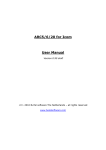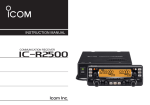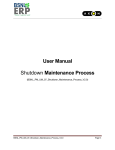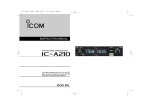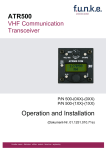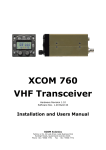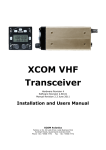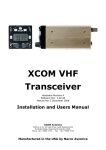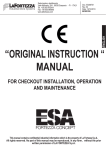Download IC-A110 Instruction Manual
Transcript
INSTRUCTION MANUAL VHF AIR BAND TRANSCEIVER iA110 This device complies with Part 15 of the FCC Rules. Operation is subject to the condition that this device does not cause harmful interference. FOREWORD READ ALL INSTRUCTIONS carefully and completely before using the transceiver. SAVE THIS INSTRUCTION MANUAL — This instruction manual contains important operating instructions for the IC-A110. EXPLICIT DEFINITIONS CAUTIONS R WARNING! NEVER operate the transceiver with a headset or other audio accessories at high volume levels. Hearing experts advise against continuous high volume operation. If you experience a ringing in your ears, reduce the volume level or discontinue use. NEVER connect the transceiver to an AC outlet or to a power source of more than 27 V DC. Such a connection will damage the transceiver. NEVER connect the transceiver to a power source that is The explicit definitions below apply to this instruction manual. WORD DEFINITION Personal injury, re hazard or electric shock RWARNING may occur. CAUTION NOTE DC fused at more than 5 A. Accidental reverse connection will be protected by this fuse, higher fuse values will not give any protection against such accidents and the transceiver will be ruined. Equipment damage may occur. DO NOT operate the transceiver near unshielded electrical If disregarded, inconvenience only. No risk of personal injury, re or electric shock. blasting caps or in an explosive atmosphere. DO NOT connect the transceiver to a power source using reverse polarity. This connection will not only blow fuses but also may damage the transceiver. Icom, Icom Inc. and the logo are registered trademarks of Icom Incorporated (Japan) in the United states, the United Kingdom, Germany, France, Spain, Russia and/or other countries. i DO NOT place unit in a non-secure place to avoid inadvertent use by children. TABLE OF CONTENTS DO NOT push the PTT when not actually desiring to transmit. AVOID using or placing the transceiver in direct sunlight or in areas with temperatures below –30°C (–22°F) or above +60°C (+140°F). AVOID FOREWORD ........................................................................................... i EXPLICIT DEFINITIONS ......................................................................... i CAUTIONS .............................................................................................. i TABLE OF CONTENTS .......................................................................... ii 1 PANEL DESCRIPTION ................................................................ 1–3 ■ Panel description .............................................................................. 1–2 ■ Function display .................................................................................... 3 2 ■ Power ON ............................................................................................. 4 ■ Channel selection .................................................................................. 4 ■ Squelch function .................................................................................... 5 ■ Side tone function.................................................................................. 5 ■ LCD backlight control ............................................................................ 5 ■ Dial select function ................................................................................ 5 placing the transceiver in excessively dusty envi- ronments. AVOID placing the transceiver against walls. This will obstruct heat dissipation. AVOID the use of chemical agents such as benzine or alcohol when cleaning, as they damage the transceiver surfaces. BE CAREFUL! The transceiver will become hot when operating continuously for long periods. FCC caution: Changes or modifications to this transceiver, not expressly approved by Icom Inc., could void your authority to operate this transceiver under FCC regulations. BASIC OPERATION ................................................................... 4 –5 3 SCAN OPERATION ..................................................................... 6–7 ■ Scan operation ..................................................................................... 6 ■ On-hook scan ....................................................................................... 7 ■ Dualwatch ............................................................................................. 7 4 MEMORY PROGRAMMING ........................................................ 8–9 ■ Programming a memory channel .......................................................... 8 ■ Memory names...................................................................................... 9 5 OTHER FUNCTIONS ............................................................... 10–11 6 CONNECTION AND INSTALLATION ..................................... 12–13 ■ Initial set mode ................................................................................... 10 ■ Rear panel and connections ............................................................... 12 ■ Mounting ............................................................................................. 13 ■ Supplied accessories........................................................................... 13 7 CLONING ...................................................................................... 14 8 9 SPECIFICATIONS ............................................................ 15–16 OPC-871 HEADSET ADAPTER........................................ 17–18 ■ OPC-871 Headset adapter .................................................................. 17 10 OPTIONS ................................................................................ 19 11 SAFETY TRAINING INFORMATION ...................................... 20 ii 1 PANEL DESCRIPTION ■ Panel description q w V/M !0 o SCAN e PRI i q TUNING [DIAL(TS)] ➥ Changes the operating frequency; memory channel in memory mode; set mode contents in set mode, etc. ➥ Push to toggle the dimmer control OFF, Low and High. ➥ Push and hold for 1 sec. to select the Tuning Step [TS]; 1 MHz or 10 kHz are available. (p. 5) w FUNCTION DISPLAY (p. 3) Displays the operating frequency, memory channel name, etc. 1 u r SQL y t e VOLUME UP [Y] DOWN [Z] KEY Adjusts the audio output level. r LOUD SPEAKER Front mounted loud speaker. t POWER SWITCH [POWER] Push and hold 500 m sec. to turn the power ON and OFF. ➥ The following functions are available at power ON as options: • Initial set mode (p. 10) • Cloning mode (p. 14) PANEL DESCRIPTION 1 y SQL SWITCH [SQL] ➥ Push to turn on the squelch adjust mode. (p. 6) ➥ Push and hold this switch for 1 sec. to turn ON/OFF the both internal and external speaker output. (p. 4) !0 MICROPHONE CONNECTOR Connects the supplied microphone or optional. NEVER connect other microphones. The pin assignments may be different and the transceiver may be damaged. u PRIORITY SWITCH [PRI] Push to select priority channel. (p. 11) MICROPHONE The supplied microphone has a PTT switch and a cradle. The following functions are available when the microphone is taken off from the hook or put back on hook: • “Pr” appears on the display. i SCAN SWITCH [SCAN] ➥ Starts and stops the scan function: ➥ Automatic scan starts when putting on hook. (p. 7) ➥ Automatic scan stops when taken off hook. (p. 7) • VFO mode: VFO scan function. • Memory mode: Memory channel scan function. (p. 6) ➥ Push and hold this switch for 5 sec. to set the displayed channel as a memory lock-out channel. (p. 8) • “LOCK OUT” appears on the display. o VFO/MEMORY SWITCH [V/M]/[MW] ➥ Push to toggle the VFO mode or the Memory mode. (p. 4) • “X” and memory channel number appear when memory mode is selected. • The transceiver has 20 memory channels. ➥When VFO mode is selected; •Push and hold this switch for 5 sec. to program the VFO frequency to memory channel. (p. 8) ➥When Memory mode is selected; • Push and hold this switch for 5 sec. to turn the “Memory name write mode” ON. NOTE: Optional functions vary with transceiver version. In this manual, optional functions are indicated by “ ” Icon. Please contact your dealer for details. 2 1 PANEL DESCRIPTION ■ Function display q w e t TX INDICATOR (p. 5) Appears while transmitting. r t !1 y FREQUENCY DISPLAY (p. 11) ➥Shows the operating frequency. ➥Shows the channel name when the memory name function is selected. (p. 10) y o i u q MEMORY MODE INDICATOR (p. 5) Appears when memory mode is selected. w DUALWATCH INDICATOR (p. 7) Indicates when the dualwatch function is activated. e SCAN INDICATOR (p. 8) Indicates when the scan function is selected. r BUSY INDICATOR (p. 6) “BUSY” appears when receiving a signal or when the squelch is open. (p. 6) 3 u VOLUME LEVEL INDICATORS ➥ Shows the AF volume level(while receiving). i SET MODE INDICATOR ➥ Appears when the Initial set mode is selected. (p. 12) o LOCK OUT INDICATOR ➥ Appears when the channel is set as a ‘LOCK OUT’ channel. (p. 8) !0 MEMORY CHANNEL INDICATOR ➥ Indicates the selected memory channel number ➥ ‘Pr’ appears when the priority channel is selected. *NOTE: The VFO/memory switch [V/M] and the memory write switch [M/W] functions may not be available depending on version. BASIC OPERATION ■ Power ON ■ Channel selection q Push [POWER] to turn power ON. ï VFO/Memory selection w Operate the transceiver as indicated in the following sections. e Select the desired memory channel (or VFO frequency) with the [V/M] keys. • When receiving a signal, appears and audio is emitted from the speaker. • Further adjustment of audio level may be necessary at this point. • Push [SQL] to adjust the squelch level. (p. 6) • Push and hold the tuning dial for 1 sec. to select the [TS], each push increments/decrements to the frequency are either 10 kHz or 1 MHz. (p. 7) r Push and hold [PTT] to transmit, then speak into the microphone. • Transmit indicator lights. t Release [PTT] to receive. 2 q Push [V/M] to select memory mode or VFO mode. ➥ Rotate the dial to select a desired frequency/channel. w During memory mode operation, push [V/M] key to transfer the memory contents to VFO. • Push [V/M] to select VFO mode. NOTE: Only frequency data is transferred even if the memory channel has a memory name. ï External speaker output control External speaker output can be turned OFF, if desired. q Push and hold [SQL] for 1 sec. w Rotate the dial to select “SP OFF”. e Push [SQL] to turn to the previous mode. NOTE: This function available for both internal and external speakers. 4 2 BASIC OPERATION ■ Squelch function ■ Dial select function The transceiver has a noise squelch circuit to mute undesired noise while receiving no signal. Use the dial select function to adjust the tuning behavior of the [DIAL] keys—use 1 MHz tuning when you want to change the frequency in large increments; use regular tuning (25 kHz or 8.33* kHz) when you want to change the frequency in smaller increments. *Except USA version D Setting the squelch level q Push [SQL] to turn the level adjusting mode ON. w Turn the tuning [DIAL] to select the squelch level. • ‘SQ 01’ is loose squelch and ‘SQ 25’ is tight squelch. (Initial level is ‘SQ 01’) • ‘SQ 01’ indicates that the squelch circuit is turned off. •“ ” appears on the display. e Push [SQL] to return to regular operation. ■ Side tone function When using an optional headset, such as those from the David Clark Co. via the OPC-871 HEAD SET ADAPTOR, the transceiver outputs your transmitted voice to the headset for monitoring. (p. 17) q Push [V/M] to select VFO mode. w Push and hold [DIAL(TS)] for 1 sec. to select the desired tuning increment. • 1 MHz tuning or regular tuning steps can be selected. (see diagrams at right) e Push and hold [DIAL(TS)] for 1 sec. to return to normal operation. 1 MHz tuning selected Regular tuning selected ■ LCD backlight control The backlight of the can be set OFF, Low or High. ➥ Push [DIAL] to toggle the backlight control; OFF, Low or High are available. 5 NOTE: Large tuning steps should be used only when you want to change the frequency in large increments. Please select regular tuning steps for normal operation. 3 SCAN OPERATION ■ Scan operation • VFO scan q Push [V/M] to select memory mode or VFO mode, if necessary. • “ MR ” appears on the memory mode. w Make sure the squelch level is set to the threshold point. • Set a squelch level (01 to 25) where the noise is muted. Repeatedly scans all frequencies over the entire band. Scan step is minimum channel spacing. (eg 25 kHz or 8.33* kHz) *Except USA version lowest frequency highest frequency Start Scan Jump e Push [SCAN] to start scan. • To change the scan direction, turn [DIAL]. • “SCAN (or P SCAN)“ flashes while scanning. ï PRIORITY SCAN •Priority memory scan r Push [SCAN] again to stop the scan. NOTE: Normal scan or Priority scan is pre-programmed by cloning. Please ask your dealer or system operator for details. While scanning on a memory mode, priority watch checks for a signal on the selected priority channel every 250 m sec except lockout channel. 250 msec. 250 msec. Priority ch SKIP Mch 1 Mch 2* Mch 3 Mch 20 *: Lockout ch ï NORMAL SCAN •Memory lock scan Repeatedly scans memory channels except skip (lockout) channels. Mch 1 Mch 2* Mch 3 SKIP Mch 20 250 msec. *: Lockout ch 6 3 SCAN OPERATION ■ On–hook scan ■ Dualwatch On–hook scan (Hanger scan) is available when taking the microphone from its hanger (off–hook) and /or returning it into the hanger (on–hook). q Push [SCAN] to start scanning. w When receiving a signal, scan pauses until the signal disappears. ➥ • You can converse by taking the microphone from the hook. e Place the microphone on the hook to restart scanning. r Scan restarts 2 sec. after the signal disappears even if you did not converse the station. Dualwatch monitors priority channel while you are receiving an other channel (VFO or memory channel). When you take the microphone during the scan operation. ➥ • In VFO scan; scan resumes promptly to frequency. ➥ • In memory scan; scan resumes promptly to memory channel. ➥ • In priority memory scan; scan resumes to priority channel, ï Operation NOTE: Be sure to connect the supplied microphone hanger to the vehicle’s ground for on/off hook microphone functions. (p. 12) 7 • If a signal is received on priority channel, dualwatch pauses on priority channel until the signal disappears. • To transmit on the selected channel during dualwatch, push and hold PTT. 250 msec. 5 sec. Priority channel VFO frequency or memory channel q Select the desired operating channel (VFO or Memory channel). w Push and hold [PRI] for 1 sec. to start dualwatch. ‘P’ blinks during dualwatch. e To cancel dualwatch, push [PRI] again. MEMORY PROGRAMMING ■ Programming a memory channel D Setting lock out channels The transceiver has 20 memory channels for storage of often -used frequencies. q Push [V/M] to select VFO mode, if necessary. w Turns the [DIAL] to select the desired frequency. q Push [V/M] to select memory mode, if necessary. • Push [DIAL/TS] one or more times to use the dial select function, if desired. e Push [V/M] for 5 sec. to enter memory programming mode. • “ MR ” and memory channel number appear. 4 In order to speed up the scan interval, you can set memory channels you don’t wish to be scanned as lock out channels. • “ MR ” appears. w Turn the [DIAL] to select a memory channel to set as a lock out channel. e Push [SCAN] for 5 sec. to toggle the lock out setting ON/OFF. • “LOCK OUT” appears when the channel is set as a lock out channel. Memory channel 8 is set as lock out channel. r Turn the [DIAL] to select the desired memory channel number. t Push [V/M] for 1 sec. to program the information into the channel and return to VFO mode. • Push [SQL] for 1 sec. to clear the memory information. *NOTE: The VFO/memory switch [V/M] and the memory write switch [M/W] functions may not be available depending on version. 8 4 MEMORY PROGRAMMING ■ Memory names ï Programming memory names q Select the memory channel to be programmed: ➥ Push [V/M] to select memory mode. ➥ Turns [DIAL] to select the memory channel. w Push [V/M] for 5 sec. to enter memory name writing mode. NOTE: •Push PTT switch to abort the programming memory name. • The following characters can be used in names: ➥ 0 to 9, A to Z (capitals), (space), $, %, ’, (, ), ✽, +, “ , ”, –, /, <, =, >, ?, @, [, \, ], ^, _ and `. • The first character of the name flashes. e Turns the [DIAL] as many times as necessary to enter the desired name. • To erase a character, overwrite with a space (displayed as _). • To move the cursor forwards or backwards, use [Y] or [Z]. • Push [SQL] for 2 sec. to erase all characters. r Push [SCAN/MW] for 2 sec. to input the set name. • Flashing stops. • Memory channels can be programmed with names of up to 7 characters in length. • When no name is programmed, the display shows the operating frequency. [EXAMPLE]: Setting the name to “ TOWER 2” V/M 9 for 5 sec. + or V/M for 1 sec. OTHER FUNCTIONS ■ Initial set mode Initial set mode is accessed at power ON and allows you to set seldom-changed settings. In this way you can “customize” transceiver operations to suit your preferences and operating style. 5 D Beep tones ON/OFF Confirmation beep tones normally sound when you push a key. These can be turned ON or OFF as you prefer. D Entering initial set mode q While pushing and holding [V/M] + [TS(DIAL)], push [POWER] sw to turn power ON. • The transceiver enters initial set mode and “MN”, “BP”, “ST” or “PR” (p. 11) appears on the display. w Push [TS(DIAL)] to select the desired item as described below and at right. e Turn [DIAL(TS)] to select the desired condition. r Push [SCAN] to exit initial set mode and select the previous operating mode. D Side tones ON/OFF When using an optional headset such as those from the David Clark Co. via the adapter, the transceiver outputs your transmitted voice to the headset for monitoring. • Optional OPC-871 HEADSET ADAPTER is required. D Memory names This item allows you to display a memory name instead of frequency. • When a memory channel has not been programmed with a name, frequency indication appears instead. 10 5 OTHER FUNCTION D Priority channel The priority channel is used to store your most often-used channel for quick recall. In addition the priority channel is monitored during priority scan modes. The default setting for the priority channel will differ depending on pre-programming. ➥ Push [PRI] to toggle the priority channel mode or previous mode. • Setting the priority channel q While pushing and holding [V/M] and [DIAL(TS)], push [POWER] to turn the power ON. • The transceiver enters initial set mode. w Push [TS(DIAL)] to select the priority channel set mode. e Select the desired channel number as a priority channel or OFF with [DIAL]. r Push [POWER] to turn power OFF. NEVER select the blank memory channel as the priority channel. In such case priority automatically sets to OFF position. 11 CONNECTION AND INSTALLATION ■ Rear panel and connections 6 Antenna › External speaker jack ⁄ ¤ fi OPC-871 HEADSET ADAPTER (Option) ‹ red: + Supplied DC power cable q Connects to an antenna Ask your dealer about antenna selection and best installation location. (Standard 50 Ω antenna with a SWR <3.0) w MICROPHONE HANGER Connect the supplied microphone hanger to the vehicle’s ground for hanger scan function when hanging or releasing the microphone. e DC POWER RECEPTACLE Connects to a 12 or 24 V DC battery. Pay attention to po- black: _ 12 V or 24 V Battery larities. NEVER connect to a over 27 V battery. This could damage the transceiver. r EXTERNAL SPEAKER JACK Connect an 8 Ω,10 W (Max.) external speaker, if desired. CAUTION : Be sure to use the external speaker’s power input rating more than 10 W, other wise the speaker damage may occur. t OPC-871 OPTIONAL HEADSET ADAPTER Connect an optional headset. (See p. 17) 12 6 CONNECTION AND INSTALLATION ■ Mounting Flat washer ■ Supplied accessories r w q e Spring washer t y u i When using self-tapping screws The universal mounting bracket supplied with your transceiver allows overhead or dashboard mounting. Please read the following instructions carefully. • Mount the transceiver securely with the 4 supplied screws (M5 × 20) to a surface which is more than 10 mm thick and can support more than 5 kg. • Mount the transceiver so that the face of the transceiver is at 90 ˚ to your line of sight when operating. 13 o !0 !1 !2 q Microphone ………………………………………………………… 1 w Microphone hanger and screw set …………………………… 1 set e Microphone cable ………………………………………………… 1 r DC power cable (OPC-344) ……………………………………… 1 t Mounting bracket …………………………………………………… 1 y Bracket bolts ………………………………………………………… 4 u Mounting screws (M5 × 12) ……………………………………… 4 i Self-tapping screws (M5 × 20) …………………………………… 4 o Flat washers ………………………………………………………… 4 !0 Spring washers …………………………………………………… 4 !1 Nuts ………………………………………………………………… 4 !2 Fuses (10 A) ………………………………………………………… 2 CLONING D Data cloning ] 7 D Cloning using PC Cloning allows you to quickly and easily transfer the programmed contents from one transceiver to another transceiver, or, data from PC to a transceiver using the optional CS-A110 cloning software. Data can be cloned to and from a PC (IBM compatible) using the optional CS-A110 CLONING SOFTWARE and the optional OPC478 CLONING CABLE+ OPC-592 CLONING CABLE ADAPTER. Consult the CS-A110 CLONING SOFTWARE HELP message for details. D Transceiver to transceiver cloning D Cloning error q Connect the OPC-591 CLONING CABLE with adapter plugs to the [MIC] jack of the master and slave transceivers. When the display at right appears, a cloning error has occurred. • The master transceiver is used to send data to the slave transceiver. w While pushing and holding [Y] + [Z] + [V/M], push [POWER] ON to enter cloning mode (master transceiver only—power ON only for slave transceiver). • “CLONE” appears and the transceivers enter the clone standby condition. e Push [POWER] on the master transceiver. • “CL-OUT” appears in the master transceiver’s display. • “CL-IN” appears automatically in the slave transceiver’s display. e When cloning is finished, turn power OFF, then ON again to exit cloning mode. In this case, both transceivers automatically return to the clone standby condition and cloning must be repeated. 14 8 SPECIFICATIONS D General • Frequency coverage • Channel spacing • Mode • Number of memory channels • Acceptable power supply (negative ground) D Receiver : 118 to 136.975 MHz : 25 kHz or 25/8.33* kHz : AM (6K00A3E) : 20 : 13.75* V or 27.5* V DC *Automatic selection • Usable temp. range : –30˚C to +60˚C • Frequency stability : ±5 ppm • Current drain (at 13.75 V DC): Tx 5 A (max.) Rx 4 A ( at AF max.) 0.5 A (at STAND BY) • Dimensions : 150 (W)✕50 (H)✕180 (D) mm (projections not incl.) 529/32(W)✕131/32(H)✕73/32(D) in • Weight : 1.5 kg; 3 lb 5 oz • Receive system • Intermediate frequencies •Sensitivity (at 6dB S/N) • Squelch sensitivity (at threshold) • Selectivity 25 kHz ch. spacing 8.33* kHz ch. spacing • Spurious response rejc, • Audio output power D Transmitter • Output power : 36 W (pep) typical 9 W (carrier) typical • Modulation : Last Stage modulation • Modulation limiting : 70 to 100 % • Audio harmonic distortion : Less than 10 % : Double conversion superheterodyne : 1st 38.85 MHz 2nd 450 kHz : Less than 1 µV (pd) : Less than 0.35 µV (pd) Side tone • Hum and noise • Audio output impedance : More than ±8 kHz (at –6 dB) Less than ±17 kHz (at –40 dB) Less than ±25 kHz (at –60 dB) More than ±2.778 kHz (at –6 dB) Less than ±7.37 kHz (at –60 dB) : More than 74 dBµ : More than 10 W (at 13.75 V DC with 8 Ω load 60 % MOD. 10% distortion) More than 100 mW (with 500 Ω load 60% MOD. 10 % distortion) : More than 25 dB : Ext. SP 8 Ω Side tone 500 Ω (at 85 % modulation) • Hum and noise ratio • Spurious emissions • Antenna impedance 15 : More than 40 dB : –16dBm or less : Standard 50 Ω with SWR <3 *Except USA version All stated specifications are subject to change without notice or obligation. SPECIFICATIONS (VFO CHANNEL ID LIST) • Channel spacing: 25 kHz (Actual frequency is displayed.) Operating Freq. Channel spacing (MHz) 118.0000 118.0250 118.0500 118.0750 118.1000 etc (kHz) 25 25 25 25 25 (MHz) 118.0000 118.0083 118.0167 118.0250 118.0333 118.0417 118.0500 118.0583 118.0667 118.0750 118.0833 118.0917 118.1000 etc • Channel spacing: 25/8.33* kHz auto selection mode Channel ID (Displayed Freq.) 118.000 118.025 118.050 118.075 118.100 • Channel spacing: 8.33* kHz Operating Freq. Channel spacing 8 Channel ID (kHz) (Displayed Freq.) 8.33 8.33 8.33 8.33 8.33 8.33 8.33 8.33 8.33 8.33 8.33 8.33 8.33 118.005 118.010 118.015 118.030 118.035 118.040 118.055 118.060 118.065 118.080 118.085 118.090 118.105 Operating Freq. Channel spacing (MHz) 118.0000 118.0000 118.0083 118.0167 118.0250 118.0250 118.0333 118.0417 118.0500 118.0500 118.0583 118.0667 118.0750 118.0750 118.0833 118.0917 118.1000 118.1000 etc Channel ID (kHz) (Displayed Freq.) 25 8.33 8.33 8.33 25 8.33 8.33 8.33 25 8.33 8.33 8.33 25 8.33 8.33 8.33 25 8.33 118.000 118.005 118.010 118.015 118.020 118.030 118.035 118.040 118.050 118.055 118.060 118.065 118.070 118.080 118.085 118.090 118.100 118.105 *Except USA version. 16 9 OPC-871 HEADSET ADAPTER (OPTION) ■ OPC-871 Headset adapter When using a headset (supplied from 3rd party) via the adapter, the transceiver outputs your transmitted voice to the headset for monitoring. (pgs. 5, 10) D Connection PTT switch Use a PTT switch with a 3.5 mm diameter plug, if required. D Installation The optional OPC-871 HEADSET ADAPTER install as follows. q Turns the power OFF, then disconnect the DC power cable. wUnscrew the 4 screws, then remove the bottom cover. (Fig. 1) e Insert the connector as shown below. (Fig. 2) r Mount the phone plug attachment together with the mobile mounting bracket with 2 supplied screws. (Fig. 3) Fig. 1 HEADSET (Must be purchased separately.) 17 OPC-871 HEADSET ADAPTER (OPTION) 9 • Use the upper side mounting hole. • You can mount the attachment on either side of the transceiver. • Bent the plastic dust cover before install the strain relief into the notch. Fig. 2 Fig. 3 18 10 OPTIONS D Other options OPC-871 HEADSET ADAPTER (See pgs. 17–18) CS-A110 CLONING SOFTWARE Provides quick and easy programming of items, including private channels, scan settings, etc., via an IBM® compatible PC (Microsoft® Windows® 95/98) to transceiver. OPC-478 CLONING CABLE OPC-592 CLONING CABLE ADAPTOR These three components work as one set and provide a quick and easy programming of items, including memory channels, memory names and set mode contents, etc. via a PC. OPC-591 CLONING CABLE Cloning cable for transceiver to transceiver. Very convenient when programming cloning process. Allows transfer of programmed contents from one transceiver to another. IBM is a registered trademark of International Business Machines. Microsoft and Windows are registered trademarks of Microsoft Corporation in the U.S.A. and other countries. 19 SAFETY TRAINING INFORMATION W ARN ING Your Icom radio generates RF electromagnetic energy during transmit mode. This radio is designed for and classified as “Occupational Use Only”, meaning it must be used only during the course of employment by individuals aware of the hazards, and the ways to minimize such hazards. This radio is NOT intended for use by the “General Population” in an uncontrolled environment. • For compliance with FCC and Industry Canada RF Exposure Requirements, the transmitter antenna installation shall comply with the following two conditions: 1. The transmitter antenna gain shall not exceed 0 dBi. 2. The antenna is required to be located outside of a vehicle and kept at a distance of 38 centimeters or more between the transmitting antenna of this device and any persons during operation. For small vehicle as worst case, the antenna shall be located on the roof top at any place on the centre line along the vehicle in order to achieve 38 centimeters separation distance. In order to ensure this distance is met, the installation of the antenna must be mounted at least 38 centimeters away from the nearest edge of the vehicle in order to protect against exposure to bystanders. 11 To ensure that your exposure to RF electromagnetic energy is within the FCC allowable limits for occupational use, always adhere to the following guidelines: C AU TIO N • DO NOT operate the radio without a proper antenna attached, as this may damage the radio and may also cause you to exceed FCC RF exposure limits. A proper antenna is the antenna supplied with this radio by the manufacturer or an antenna specifically authorized by the manufacturer for use with this radio. • DO NOT transmit for more than 50% of total radio use time (“50% duty cycle”). Transmitting more than 50% of the time can cause FCC RF exposure compliance requirements to be exceeded. The radio is transmitting when the “TX indicator” appears. You can cause the radio to transmit by pressing the “PTT” switch. Electromagnetic Interference/Compatibility During transmissions, your Icom radio generates RF energy that can possibly cause interference with other devices or systems. To avoid such interference, turn off the radio in areas where signs are posted to do so. DO NOT operate the transmitter in areas that are sensitive to electromagnetic radiation such as hospitals, aircraft, and blasting sites. 20 A-5616H-1EX-w Printed in Japan © 1999–2006 Icom Inc. 1-1-32 Kamiminami, Hirano-ku, Osaka 547-0003, Japan
























